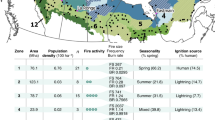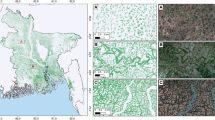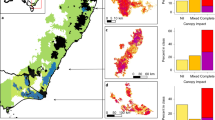Abstract
African forests suffer from severe fragmentation that further causes forest degradation near forest edges. The impact of fires used for slash-and-burn on forest edge effects remains unclear. Here, using high-resolution satellite-based forest-cover and biomass datasets, we find that edge effects extend a median distance and an interquartile range of \(0.11_{ - 0.04}^{ + 0.06}\,{\mathrm{km}}\) and \(0.15_{ - 0.05}^{ + 0.09}\,{\mathrm{km}}\) into moist and dry forests, and biomass within the forest edge zones has a carbon deficit of 4.1 PgC. Fires occurred in 52% of the forest edges and increased the carbon deficit by \(5.5_{ - 2.9}^{ + 4.3}\,{\mathrm{MgC}}\,{\mathrm{ha}^{{-1}}}\), compared with non-fire edges, through both the direct impact of fires intruding into forests and the indirect impact of changes in the local atmospheric circulations increasing canopy dryness. If small-scale slash-and-burn practices continue, increased fragmentation during 2010–2100 will result in a carbon loss from edge effects of 0.54–4.6 PgC. Fragmentation-caused forest degradation could be avoided by implementing dedicated forest protection policies supported by satellite monitoring of forest edges.
This is a preview of subscription content, access via your institution
Access options
Access Nature and 54 other Nature Portfolio journals
Get Nature+, our best-value online-access subscription
$29.99 / 30 days
cancel any time
Subscribe to this journal
Receive 12 print issues and online access
$259.00 per year
only $21.58 per issue
Buy this article
- Purchase on Springer Link
- Instant access to full article PDF
Prices may be subject to local taxes which are calculated during checkout



Similar content being viewed by others
Data availability
The 30 m forest-cover map (v1.7) from Hansen et al.21 can be downloaded from https://earthenginepartners.appspot.com/science-2013-global-forest/download_v1.7.html. The 25 m full-resolution GlobBiomass map for Africa from Santoro et al.23 can be downloaded from https://zenodo.org/record/4725667. The global and official 100 m GlobBiomass map22 can be downloaded from http://globbiomass.org/products/global-mapping or https://doi.pangaea.de/10.1594/PANGAEA.894711. The fire data from FireCCI24 can be downloaded from https://doi.org/10.5285/58f00d8814064b79a0c49662ad3af537. Source data are provided with this paper.
Code availability
All additional computer codes are available from the corresponding author on request.
References
Pan, Y. D. et al. A large and persistent carbon sink in the world’s forests. Science 333, 988–993 (2011).
Baccini, A. et al. Estimated carbon dioxide emissions from tropical deforestation improved by carbon-density maps. Nat. Clim. Change 2, 182–185 (2012).
Matricardi, E. A. T. et al. Long-term forest degradation surpasses deforestation in the Brazilian Amazon. Science 369, 1378–1382 (2020).
Bullock, E. L., Woodcock, C. E., Souza, C. & Olofsson, P. Satellite-based estimates reveal widespread forest degradation in the Amazon. Glob. Change Biol. 26, 2956–2969 (2020).
Aragao, L. E. O. C. et al. 21st century drought-related fires counteract the decline of Amazon deforestation carbon emissions. Nat. Commun. 9, 536 (2018).
Chaplin-Kramer, R. et al. Degradation in carbon stocks near tropical forest edges. Nat. Commun. 6, 10158 (2015).
Taubert, F. et al. Global patterns of tropical forest fragmentation. Nature 554, 519–522 (2018).
Kunert, N., Teophilo Aparecido, L. M., Higuchi, N., dos Santos, J. & Trumbore, S. Higher tree transpiration due to road-associated edge effects in a tropical moist lowland forest. Agric. For. Meteorol. 213, 183–192 (2015).
Broadbent, E. N. et al. Forest fragmentation and edge effects from deforestation and selective logging in the Brazilian Amazon. Biol. Conserv. 141, 1745–1757 (2008).
Laurance, W. F. et al. Biomass collapse in Amazonian forest fragments. Science 278, 1117–1118 (1997).
Qie, L. et al. Long-term carbon sink in Borneo’s forests halted by drought and vulnerable to edge effects. Nat. Commun. 8, 1966 (2017).
Haddad, N. M. et al. Habitat fragmentation and its lasting impact on Earth’s ecosystems. Sci. Adv. 1, e150005 (2015).
Briant, G., Gond, V. & Laurance, S. G. W. Habitat fragmentation and the desiccation of forest canopies: a case study from eastern Amazonia. Biol. Conserv. 143, 2763–2769 (2010).
Laurance, W. F. et al. The fate of Amazonian forest fragments: a 32-year investigation. Biol. Conserv. 144, 56–67 (2011).
FAOSTAT Database (FAO, 2020); http://www.fao.org/faostat/en/#data/FO
World Urbanization Prospects: The 2018 Revision (UN Department of Economic and Social Affairs, 2018).
Brandt, M. et al. Reduction of tree cover in West African woodlands and promotion in semi-arid farmlands. Nat. Geosci. 11, 328–333 (2018).
Hufkens, K. et al. Historical aerial surveys map long-term changes of forest cover and structure in the central Congo basin. Remote Sens. 12, 638 (2020).
van der Werf, G. R. et al. Global fire emissions and the contribution of deforestation, savanna, forest, agricultural, and peat fires (1997–2009). Atmos. Chem. Phys. 10, 11707–11735 (2010).
Ichoku, C. et al. Biomass burning, land-cover change, and the hydrological cycle in northern sub-Saharan Africa. Environ. Res. Lett. 11, 095005 (2016).
Hansen, M. C. et al. High-resolution global maps of 21st-century forest cover change. Science 342, 850–853 (2013).
Santoro, M. et al. The global forest above-ground biomass pool for 2010 estimated from high-resolution satellite observations. Preprint at Copernicus https://doi.org/10.5194/essd-2020-148 (2020).
Santoro, M. & Cartus, O. GlobBiomass dataset of forest biomass, Africa (25 m). Zenodo https://doi.org/10.5281/zenodo.4725667 (2020).
Chuvieco, E., Pettinari, L. M., Lizundia Loiola, J., Storm, T. & Padilla Parellada, M. ESA Fire Climate Change Initiative (Fire_cci): MODIS Fire_cci Burned Area Grid Product Version 5.1 (Centre for Environmental Data Analysis, 2019).
Friedl, M. & Sulla-Menashe, D. MCD12Q1 MODIS/Terra+Aqua Land Cover Type Yearly L3 Global 500m SIN Grid V006 (NASA EOSDIS Land Processes DAAC, 2019); https://doi.org/10.5067/MODIS/MCD12Q1.006
Laurance, W. F. Theory meets reality: how habitat fragmentation research has transcended island biogeographic theory. Biol. Conserv. 141, 1731–1744 (2008).
Brinck, K. et al. High resolution analysis of tropical forest fragmentation and its impact on the global carbon cycle. Nat. Commun. 8, 14855 (2017).
Kato, S. et al. Surface irradiances of edition 4.0 Clouds and the Earth’s radiant Energy System (CERES) Energy Balanced and Filled (EBAF) data product. J. Clim. 31, 4501–4527 (2018).
Running, S., Mu, Q. & Zhao, M. MOD16A2 MODIS/Terra Net Evapotranspiration 8-Day L4 Global 500m SIN Grid V006 (NASA EOSDIS Land Processes DAAC, 2017); https://doi.org/10.5067/MODIS/MOD16A2.006
Hurtt, G. C. et al. Harmonization of global land-use change and management for the period 850–2100 (LUH2) for CMIP6. Geosci. Model Dev. 13, 5425–5464 (2020).
Gaviria, J., Turner, B. L. & Engelbrecht, B. M. J. Drivers of tree species distribution across a tropical rainfall gradient. Ecosphere 8, e01712 (2017).
Alemayehu, T., van Griensven, A., Woldegiorgis, B. T. & Bauwens, W. An improved SWAT vegetation growth module and its evaluation for four tropical ecosystems. Hydrol. Earth Syst. Sci. 21, 4449–4467 (2017).
Kotto-Same, J., Woomer, P. L., Appolinaire, M. & Louis, Z. Carbon dynamics in slash-and-burn agriculture and land use alternatives of the humid forest zone in Cameroon. Agric. Ecosyst. Environ. 65, 245–256 (1997).
Tyukavina, A. et al. Congo basin forest loss dominated by increasing smallholder clearing. Sci. Adv. 4, eaat2993 (2018).
Rejou-Mechain, M. et al. Local spatial structure of forest biomass and its consequences for remote sensing of carbon stocks. Biogeosciences 11, 6827–6840 (2014).
Tropek, R. et al. Comment on “high-resolution global maps of 21st-century forest cover change”. Science 344, 981 (2014).
Global Forest Watch (World Resources Institute, 2019); https://data.globalforestwatch.org/datasets/planted-forests
Roteta, E., Bastarrika, A., Padilla, M., Storm, T. & Chuvieco, E. Development of a Sentinel-2 burned area algorithm: generation of a small fire database for sub-Saharan Africa. Remote Sens. Environ. 222, 1–17 (2019).
Bouvet, A. et al. An above-ground biomass map of African savannahs and woodlands at 25 m resolution derived from ALOS PALSAR. Remote Sens. Environ. 206, 156–173 (2018).
Laurance, S. G. W. Responses of understory rain forest birds to road edges in central Amazonia. Ecol. Appl. 14, 1344–1357 (2004).
Cochrane, M. A. & Laurance, W. F. Synergisms among fire, land use, and climate change in the Amazon. AMBIO 37, 522–527 (2008).
Khanna, J., Medvigy, D., Fueglistaler, S. & Walko, R. Regional dry-season climate changes due to three decades of Amazonian deforestation. Nat. Clim. Change 7, 200–204 (2017).
Brienen, R. J. W. et al. Long-term decline of the Amazon carbon sink. Nature 519, 344–348 (2015).
Acknowledgements
This study was supported by the National Key R&D Program of China (no. 2019YFA0606604, to W.L.). The authors also acknowledge funding from the ANR CLAND Convergence Institute (16-CONV-0003, to P.C.), the European Space Agency (ESA) within the CCI Biomass project (contract 4000123662/18/I-NB, to P.C.), the National Natural Science Foundation of China (grant no. 41971132 and grant no. U20A2090, to C.Y.), the Strategic Priority Research Program of Chinese Academy of Sciences (grant no. XDB40020305, to C.Y.) and the National Key Scientific and Technological Infrastructure project ‘Earth System Science Numerical Simulator Facility’ (EarthLab, to L.Y.). The global AGB dataset was generated as part of the European Space Agency (ESA) Data User Element (DUE) GlobBiomass project (ESRIN contract no. 4000113100/14/I-NB).
Author information
Authors and Affiliations
Contributions
W.L. designed the research. Z.Z. performed analysis. M.S. and O.C. processed the biomass map data. Z.Z. and W.L. drafted the paper. All authors contributed to the interpretation of the results and to the text.
Corresponding author
Ethics declarations
Competing interests
The authors declare no competing interests.
Additional information
Peer review information Nature Geoscience thanks Rico Fischer and other, anonymous, reviewer(s) for their contribution to the peer review of this work. Primary Handling Editor: Xujia Jiang.
Publisher’s note Springer Nature remains neutral with regard to jurisdictional claims in published maps and institutional affiliations.
Extended data
Extended Data Fig. 1 Schematic of edge effects characterization.
Scale of the edge effects is the distance (km) where the biomass equals p % of the estimated biomass of interior forest (p=90 in this study). Magnitude is the difference (%) of biomass between interior forest and forest edge. We used d km away from the edge in practice to avoid negatives due to bad fittings. d=0.015 km is used in this study and d=0.232 km is used for the comparison with Chaplin-Kramer et al. (Supplementary Discussion 1).
Extended Data Fig. 2 Average tree cover of all forest pixels in each grid cell.
Shading in (c) indicates the interquartile ranges, and dashed lines indicate medians.
Extended Data Fig. 3 Frequency distributions of Δβ and β for different types of pixels across Africa.
a, Δβ is calculated as β at fire edge minus β at non-fire edge. b, β for different types of pixels (moist forest, dry forest, fire edge, non-fire edge). Shading in (a) indicates the weighted interquartile range, and the dashed line indicates the weighted median. Δβ > 0 was found in 66% of the grid cells. The order of β for different pixel types is: moist forest < dry forest < non-fire edge < fire edge.
Extended Data Fig. 4 Different scenarios of forest pixel (30 m) loss during the period 2010–2100.
Deforestation fraction between 2015 and 2100 for RCP2.6 and RCP8.5, derived from LUH2 v2f (0.25°), was used as an approximation to deforestation fraction between 2010 and 2100 for each grid cell. We only focused on grid cells with forest loss, and the gross forest loss area in Africa is the sum of the forest loss areas of these grid cells. We created four scenarios to match the deforestation fraction in each grid cell: (1) all pixels starting from current forest edges are deforested from the outer edge inwards until the target deforestation area is achieved, and thus new edges are created (S-1); (2) small forest patches are cleared first to minimize new forest edges (S-2); (3) pixels in the interior of forest are preferentially deforested (S-3); (4) pixels are deforested randomly, maximizing the area of new forest edges (S-4).
Extended Data Fig. 5 Local circulation that draws moisture from the forest edge zone to the edge.
The Schematic is adapted from Laurance et al. (2011)14. Edge effects result from local circulations that draw down moisture due to the gradient of β between forest edges and nearby forest patches. Fire-related edges have even higher β than non-fire edges, which enhances local circulations and edge effects. Two possible ways of fire influencing edge effects were defined: direct impact, i.e. direct burning of trees and understories, and indirect impact, i.e., fire-enhanced β at fire-edges compared to non-fire edges. The frequency distributions of β in the forest edge zone and at different edges are shown in Fig. E3.
Extended Data Fig. 6 Fraction of forest pixels with AGB > 250 Mg ha-1.
a-b, Frequency distributions of forest pixel (30 m × 30 m) AGB. Only 0.25° grids where edge effects were successfully detected were used. c-d, The fraction of forest pixels with AGB > 250 Mg ha-1 in each 0.25° grids where edge effects were successfully detected. Shading area in (a) and (b) indicates the interquartile ranges, and dashed lines indicate the medians.
Extended Data Fig. 7 AGB bias of the GlobBiomass map at different AGB levels.
Data of the solid line is from Supplementary Fig. S8 in Santoro et al. (2020)22, and data of the dots is based on field observations in the Amazon from Brienen et al. (2015)43. The field plot data in the Amazon were aggregated at each interval of 5 Mg ha-1, and the dots and error bars indicate means and standard deviations of GlobBiomass AGB in each 5 Mg ha-1 intervals.
Extended Data Fig. 8 Schematic of different types of forests and edges.
Hierarchical structure of pixels is described in Supplementary Methods. β values were averaged over fire- and non-fire edges separately in the same 0.25° grid cell, and Δβ (fire minus non-fire) was used as indicator of indirect fire impact on edge effects. The fire distance was used as an indicator of the direct impact of fires on edge effects. The median distance that fire burns into forests of forest pixels with fire edges (MF and DF) was used for each 0.25° grid cell.
Supplementary information
Supplementary Information
Supplementary methods, Discussions 1–3, Tables 1–3 and Figs. 1–7.
Source data
Source Data Fig. 1
Statistical source data.
Source Data Fig. 2
Statistical source data.
Source Data Fig. 3
Statistical source data.
Source Data Extended Data Fig. 2
Statistical source data.
Source Data Extended Data Fig. 3
Statistical source data.
Source Data Extended Data Fig. 6
Statistical source data.
Source Data Extended Data Fig. 7
Statistical source data.
Rights and permissions
About this article
Cite this article
Zhao, Z., Li, W., Ciais, P. et al. Fire enhances forest degradation within forest edge zones in Africa. Nat. Geosci. 14, 479–483 (2021). https://doi.org/10.1038/s41561-021-00763-8
Received:
Accepted:
Published:
Issue Date:
DOI: https://doi.org/10.1038/s41561-021-00763-8
This article is cited by
-
Comparable biophysical and biogeochemical feedbacks on warming from tropical moist forest degradation
Nature Geoscience (2023)
-
The hidden warming effects of the degradation of tropical moist forests
Nature Geoscience (2023)
-
Changes in vegetation greenness related to climatic and non-climatic factors in the Sudano-Sahelian region
Regional Environmental Change (2023)
-
Anthropogenic evidences as precursors to forest fire trigger in Western Himalayan Region
Environment, Development and Sustainability (2023)
-
Accounting for forest fire risks: global insights for climate change mitigation
Mitigation and Adaptation Strategies for Global Change (2023)



